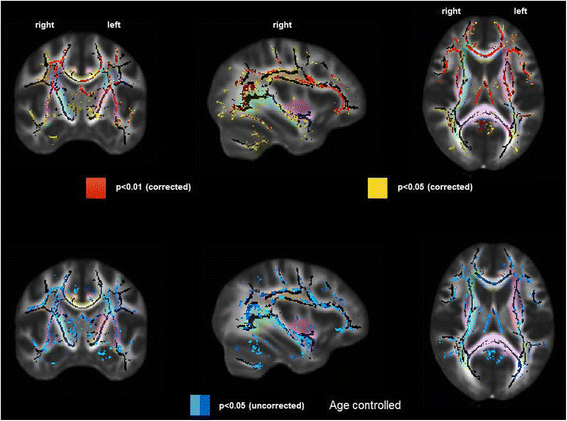White matter damage in maintenance hemodialysis patients: a diffusion tensor imaging study
- PMID: 28676035
- PMCID: PMC5497357
- DOI: 10.1186/s12882-017-0628-0
White matter damage in maintenance hemodialysis patients: a diffusion tensor imaging study
Abstract
Background: Patients treated with dialysis have high rates of brain infarcts, brain atrophy, and white matter disease. There are limited data regarding the presence of more subtle damage to brain white matter.
Methods: In the Cognition and Dialysis Study, we compared brain structure using diffusion tensor imaging in hemodialysis (HD) patients to individuals without known kidney disease, using tract based spatial statistics (TBSS) to compare Fractional Anisotropy (FA) and Mean Diffusivity (MD). Statistical comparison of each overlaid voxel was age controlled using a permutation based corrected p value of <0.05.
Results: Thirty-four HD patients and twenty six controls (52 vs 51 years for HD vs control) had adequate magnetic resonance imaging for analysis. The HD group had fewer women (38% vs 23%) and a higher prevalence of diabetes (29% vs 8%), heart failure (29% vs 0%) and clinical stroke (15% vs 0%). Hemodialysis patients had significantly lower FA across multiple white matter fiber tracts, with fronto-temporal connections, the genu of the corpus callosum and the fornix more significantly affected than posterior regions of the brain. Similarly, HD patients had significantly higher mean diffusivity in multiple anterior brain regions. Results remained similar when those with a prior history of stroke were excluded.
Conclusions: In HD patients, there is more white matter disease in the anterior than posterior parts of the brain compared to controls without kidney disease. This pattern of injury is most similar to that seen in aging, suggesting that developing chronic kidney disease and ultimately kidney failure may result in a phenotype consistent with accelerated aging.
Conflict of interest statement
Ethics approval and consent to participate
The Tufts MC Institutional Review Board approved the study, and all participants signed informed consent allowing for review of individual medical records as well as participation in the study.
Consent for publication
Not applicable.
Competing interests
The authors declare that they have no competing interests.
Publisher’s Note
Springer Nature remains neutral with regard to jurisdictional claims in published maps and institutional affiliations.
Figures



References
MeSH terms
Grants and funding
LinkOut - more resources
Full Text Sources
Other Literature Sources
Medical

